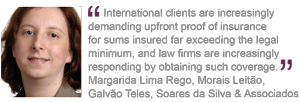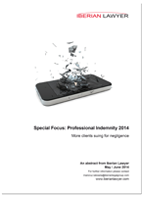Professional Indemnity Special Report 2014: More clients suing for negligence
The number of court cases involving professional negligence claims against lawyers in Iberia is increasing due to clients being better informed about their rights, law firms employing fewer fee earners and more junior lawyers increasingly being used on cases and deals. So how can law firms reduce the risk of being sued for negligence?
Concern has been mounting that professional negligence claims against lawyers in Iberia are on the rise, with anecdotal evidence suggesting that in Spain, for example, the last decade has seen claims against lawyers increase almost three-fold. One of the factors thought to be behind the rise is the impact the recession has had on the way in which law firms work.
Ana Dores, XL Group’s senior professional indemnity underwriter for Iberia and Latin America, believes that law firms have made substantial changes in terms of the number of lawyers they employ and, while this made firms more competitive, at the same time it has raised concerns for insurers. “Less personnel are handling the same or even a greater workload, and less experienced lawyers now represent a higher proportion of the teams,” she says. “This, obviously, could potentially have an impact on the number of errors and omissions, and consequently there are more claims.” And the bad news for law firms is that the risk of being on the wrong end of professional negligence claims is set to increase. Dores says: “This is especially a risk in the coming years as activity levels rise as expected due to the improvement of economic perspectives.”
As such, law firms deciding to use more inexperienced lawyers increases the risk of a negligence claim. This is because most PI claims are often based on relatively simple errors by lawyers rather than firm-wide gross misconduct allegations.
“Most of the professional indemnity claims are due to fiscal advice, procedural issues, and issues relating to patents and trademarks – in general in all those areas where there are deadlines,” Esteban Manzano, director general at Markel International in Spain says. lnsolvency administration, which is a common trend amidst the financial crisis, is one area highlighted by Manzano as giving rise to claims.
Claims increase nearly three-fold
So by how much are claims increasing? Juan Antonio Ruiz, a litigation partner at Cuatrecasas, Gonçalves Pereira, says that while there is no empirical information collected, searches in case law databases show that courts would decide around 30 cases a year on lawyers liability in the 1990s, but that in the last 10 years, courts are deciding around 80 cases per year. However, he adds: “These figures are misleading, given that legal databases have broader access to court decisions now than they had in the 1990s. Our perception though is that claims against law professionals have increased, not only because the literature says so, but because it is common knowledge in the professions that this increase is real.”
Virginia Martínez, associate at Hogan Lovells, highlights three common grounds for a professional indemnity claim. The first is negligent advice provided by a lawyer to their client, such as the failure to inform a client about the low probabilities of success relating to a claim or an appeal. Other frequently cited reasons for a claim include the failure to file a claim within the prescription or limitation periods – for example, a tort liability action must be exercised within a one-year term beginning from the date of the damages – and failure to file an appeal within the term given by law.
Litigious work is the main source of professional negligence claims against lawyers in Spain and Portugal. Ruiz says complaints against lawyers were uncommon until a few years ago but have been increasing in relation to instructing legal proceedings. “The following circumstances of lawyers’ liability stand out: allowing substantive prescription or expiry periods for submitting complaints to elapse; allowing procedural periods for answering complaints or filing appeals to elapse; not giving clients information; omitting relevant requests or elements from legal writs; and failing to return documentation provided by clients.”
Don´t miss deadlines
Dores agrees that missing deadlines is risky, adding that one of the key points is that the limitation periods established in the Procedural Rules are compulsory, which means that they cannot be changed by the defendant, plaintiff or the judge. Citing “preclusion”, or the barring principle, she says: “According to this rule, each stage of the proceedings has a fixed and final deadline which cannot be extended and beyond which no further applications, motions, submissions and so on, are admissible.”
She adds: “Decisions and orders based on each completed stage are therefore irrevocable. The parties must attach, to the Particular of Claims or to their defence, all the documents or evidence on which their allegations are founded. The parties must also set out in details each specific allegation.” The consequence of preclusion is that when a lawyer has missed a deadline, such as the legal 20-day period to submit a defence, the defendant has not got the right to submit such a defence or the corresponding allegations or documents. Paulo Cruz Almeida, partner at Kennedys in Lisbon, cites the example of Portuguese decree law 303/2007, which changed the appeal deadlines and gave rise to several situations where lawyers were left exposed to claims because confusion over the new deadlines led to them being missed.
Other insurers are seeing an increase in claims relating to areas other than litigation. Almudena Benito, Madrid-based director of professional indemnity in Willis´ FINEX division, says the main areas in which the insurance broker has seen professional indemnity claims are M&A, real estate and banking. Market insiders also cite tax advice, medical malpractice advice and insolvency proceedings as areas giving rise to professional indemnity claims – insurers observe there has been an increase in requests for insurance from lawyers acting as insolvency administrators, a role that is in demand in light of the economic crisis. Insurers point out that claims from international clients, in particular, are on the rise, resulting in medium-sized and large firms looking to increase their limit of indemnity.
Margarida Lima Rego, a senior lawyer at Morais Leitão, Galvão Teles, Soares da Silva & Associados, says it was very difficult for a Portuguese law firm to obtain insurance coverage for sums comparable to those obtainable in most of Western Europe up until a few years ago. She adds: “The situation is now very different, as it is possible for a law firm to negotiate professional liability insurance up to the desired sum. International clients are increasingly demanding upfront proof of insurance for sums insured far exceeding the legal minimum, and law firms are increasingly responding by obtaining such coverage.”
Big business
The good news for lawyers is that professional indemnity insurance is getting cheaper. Benito says the Spanish professional indemnity insurance market continues to offer cheaper rates, given the increased competition and capacity for this type of risk: “Notwithstanding the main insurers writing the majority of this business at competitive rates, broader cover remains the same as in the last few years.”
Professional indemnity insurance (PII) – which protects lawyers and a range of other professions (including architects, doctors, and engineers) against negligence claims has become big business during this time. That said, the market has decreased in size in recent years. In Spain, for instance, the overall size of the PII market in terms of gross written premiums was estimated at €417.7 million in 2009, according to market research company Finaccord. By 2013, that figure had dropped to €393.3 million.
Bernd Bergmann, a consultant at Finaccord, notes: “We estimate that there has been an especially severe decline in the Spanish PII market for the segments of estate agency and property, marketing professionals and architecture and engineering, due to worsening economic conditions in the underlying segments. By comparison, the PII market conditions for the legal services segment have been more stable.”
Claims relatively rare
Legal services have traditionally been less risky that other professions. The robust ´counter-cyclical´ nature of the work – which is mainly theoretical without the physical risk seen in other areas, such as medical and construction – and the specialism of law firms (lawyers are probably the best-placed profession when it comes to fighting negligence claims) have made claims relatively rare.
This lack of claims encouraged more insurers into the legal PII market. Manzano says that 10 years ago the PII market was very concentrated, with most policies held by specialist firms. “Since the financial crisis, however, many more insurers have decided to enter the market,” he adds. “Competition has become very intense and driven down the costs considerably, to the point some lawyers can get an annual PII policy for as low as €50.”
Bergmann adds that Finaccord research found that PII policies for lawyers in Spain are significantly less expensive than most other European countries. He says: “In fact, we estimate that of the 10 countries we covered for the report (Austria, Belgium, France, Germany, Italy, the Netherlands, Poland, Spain, Switzerland and the UK) only lawyers in Poland enjoy lower premium rates for PII.”
It is a slightly different story in Portugal. Dores says that while an excess of capacity was driving Spanish pricing downwards, Portugal has fewer insurers offering PII. “The PI market is largely handled by the Lawyers Bar collective insurance programme, Ordem dos Advogados,” she explains. “The pricing of this scheme is probably the best barometer of the market conditions in Portugal.”
According to the Council of Bars and Law Societies of Europe (CCBE), PII schemes are obligatory for individual lawyers and law firms in Portugal. Under Ordem dos Advogados rules, the association grants each individual registered lawyer minimum coverage of €150,000 (additional coverage can be purchased on top of this). The minimum PI coverage needed by a law firm is 50 percent of the amounts billed by the firm in the previous year.
“Portuguese lawyers are subject to the general civil liability rules which apply to all citizens,” according to the CCBE. “The nature of civil liability applying to client-lawyer relationship is still discussed by scholars. However, major jurisprudence tends to consider such liability to be contractual or non-contractual depending on the concrete situation. Thus, if the lawyer fails to perform or performs defectively the obligations arising from the mandate he or she may by be held liable according to contractual liability rules – if, on the other hand, the lawyer commits an offence harming the interest of his client, then only non-contractual liability rules may apply.”
Take precautions
However, though professional indemnity cover is competitively priced and wider coverage is increasingly available, Iberian lawyers are reminded that there are some basic precautions that can be taken to reduce the risk of being subject to a claim. There are also steps that can be taken to ensure deadlines are kept, which will also minimise the risk of a claim.
Transparency and due diligence are important, especially for firms with large headcounts and international exposure.
“It is important that internal protocols are in place in order to identify potential conflicts of interest,” Benito says. “This is particularly the case in larger firms, where these conflicts can frequently arise given the volume and size of their clients.”
In Spain, Ruiz observes that legal professionals’ liability is ordinary liability, specifically liability by negligence or fault. Therefore, in legal professions, the work must meet the diligence level required in each case, which is greater than the usual “prudent man” in article 1104 of the Spanish Civil Code, as established by the Spanish Supreme Court Judgment dated February 4, 1992. He adds that this involves: “Keeping [clients] promptly informed, obtaining their written consent for any actions to be performed, sharing opinions regarding draft contractual or procedural writs and having them participate in everything related to defending their interests.”
Dores encourages firms to inform clients about the pro and cons of their case. “Judges will tend to hold the lawyer liable if they are not able to prove that they informed their client about the risks of their cases,” Dores explains. “Thus, it is important that the information of the risk of the case is communicated in writing to the clients.”
This is echoed by Jose Pimentel, partner at DAC Beachcroft Spain, who says: “Give clear advice, be proactive in the handling of the cases and take a pro-settlement attitude, when applicable.”
Martínez stresses that lawyers should always inform clients about the actual probabilities of success and about the possible costs involved, such as paying the other party’s legal costs if the case is not upheld: “Lawyers must be very careful when issuing opinions, inserting disclaimers regarding the information that has actually been provided.”
Experts also emphasise the importance of experience, ensuring that academic education is complemented by practical know-how as it is younger lawyers that are more likely to make mistakes.
Eduardo Albors, director of Albors Galiano Portales, concludes: “This knowledge about how to handle claims accomplishes one of the essential ingredients of how due diligence applies – the other important ingredient is more connected to the general understanding about the service side of the work to perform, in which the lawyer’s approach is to be framed by the knowledge that the main goal is to provide the best service possible to protect the client’s interests.”











